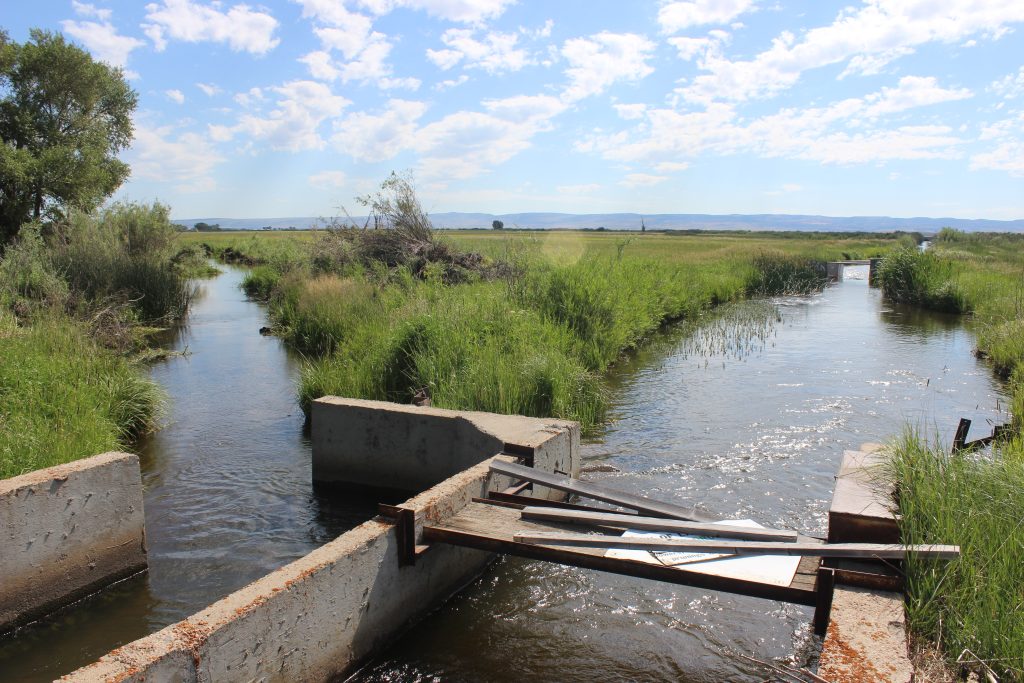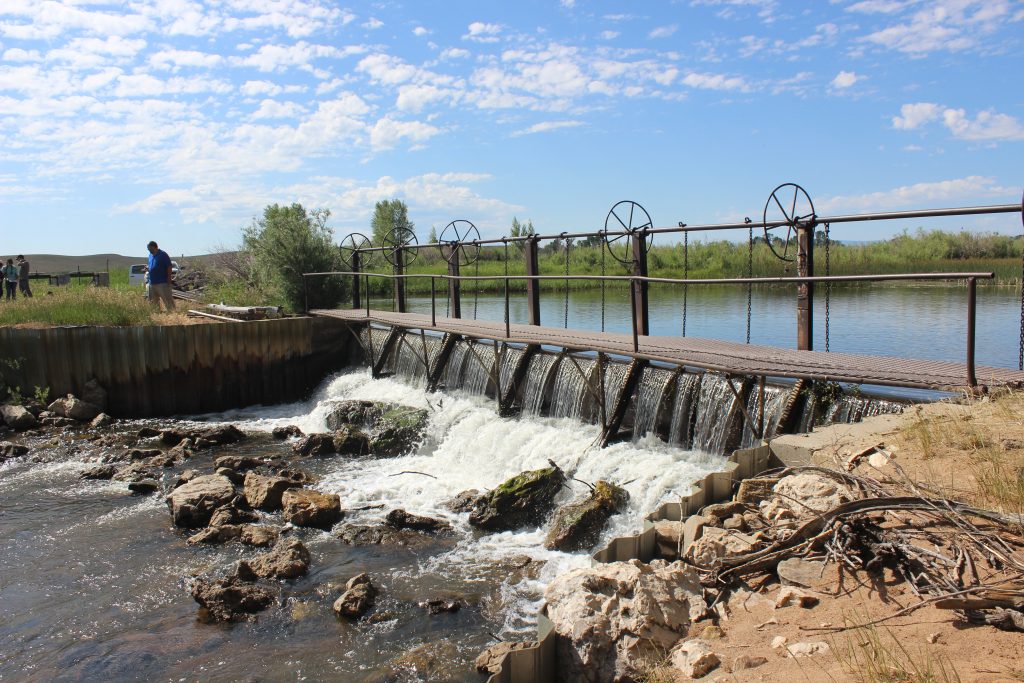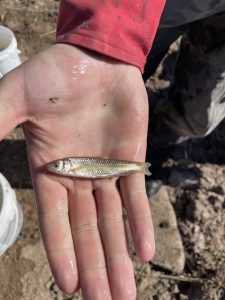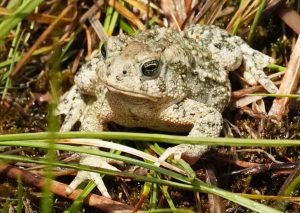Planning for the Future on the Laramie Plains
Updating Infrastructure to Protect Water and Wetlands

In winter, the Hart Ranch is still. What water there is on the land, both here and across the Laramie Plains, is frozen. Bone-bare cottonwoods and the gnarled branches of shrubs line empty ditches and the Laramie River’s floodplain. The ground is tawny and fallow between the snow storms that blow like freight trains down from the continental divide.
Come spring, however, the dry brown grasses will be covered by a pulse of irrigation water spreading out in sheets from the ditches that weave through the meadows. And that’s when the birds will arrive.
Between agricultural fields like this one that line the riparian corridors of the Laramie Plains and local National Wildlife Refuges like Hutton Lake and Mortenson Lake, this landscape is a locus for migratory birds in the spring and early summer months.
“These shallow-water, food-rich environments are filled with invertebrates and seeds and everything needed by birds migrating north,” said Tom Peterson, the Manager of Conservation Programs for Ducks Unlimited in Wyoming and western Nebraska. “That’s why the timing of spring runoff and the flood irrigation practices that happen along the Laramie River and across the West are so extremely important to migratory birds.”
After being managed for nearly a century as a cattle ranch, the Hart Ranch still follows the seasonal rhythms of a working ranch: flood irrigating in the spring, cutting hay, and grazing in the summer. But now, instead of belonging to a ranching family, the land has an interesting combination of new owners: the City of Laramie and the U.S. Fish and Wildlife Service (USFWS). In 2023, the USFWS acquired part of the Hart Ranch through a partnership with The Conservation Fund in order to protect habitat and agricultural water resources for migratory birds, native fish, and a rare species of amphibian; the Wyoming Toad (see sidebar). The year prior, the City of Laramie had purchased the other part of the Hart Ranch to secure the water rights that came with the parcel (the oldest right on the Laramie River), as well as open space along the river. Together, the USFWS and the city are hoping to manage the ranch for a slew of benefits, from keeping the ranch’s flood-irrigated meadows wet for migratory birds to improving fish passage in the Laramie River by updating infrastructure on the property.
A driving force for this effort (and many other collaborative conservation projects across the Laramie Plains) is the USFWS Partners for Fish and Wildlife Program. Mindy Meade, the Partners for Fish and Wildlife biologist based out of Laramie, said that the USFWS and the City of Laramie each acquired part of the Hart Ranch in order to keep its water on the landscape. For the City of Laramie, the water rights associated with the Hart Ranch mean resilient water supplies for potential future municipal use. For the USFWS, that water equates to conservation outcomes, like resilient habitat for birds, fish, and wildlife that can improve landscape-level biodiversity.
Meade said that continued agricultural management allows both needs to be met. The flood irrigation practices not only support wildlife habitat on the parcel but also ensure that the water isn’t purchased by outside communities and piped out of the watershed to the growing cities of the Front Range. Furthermore, she said, agricultural practices on the ranch can be a tool for habitat management, like grazing cattle to keep plants like cattails from overtaking the more nutrient-dense plants like sedges or flood-irrigating to create wetland habitat in the spring and raise hay to cut in the summer. Revenue generated by the agriculture also helps the city improve infrastructure to ensure the water rights are usable.
“By allowing the agriculture to happen strategically, you’re not only improving the habitat, you’re allowing the city to raise money for improvements without burdening the taxpayers,” she said.
With the new dual ownership of the Hart Ranch comes the responsibilities of management, including maintaining the flood irrigation infrastructure lacing the property. When irrigation infrastructure starts to fail and becomes difficult to operate, it is easy for whoever is managing the water to consider less labor-intensive options like converting to sprinkler systems. And sometimes when municipalities acquire land for water rights and open space, the decision will be made to do away with the irrigation entirely. But Jay Smith, the Natural Resource Program Administrator for the City of Laramie, said that wasn’t an option considered by the city.
“Just drying up land does not help anyone,” he said. “It makes a very valuable investment that the city has made [worthless]. Going in and purchasing these wetlands and pulling the water off devalues what we have, not only from an economic standpoint but from an aesthetic standpoint and those other beneficial uses.”
Smith said that one of the immediate management objectives for the city was working with partners to rehabilitate the Dowlin Ditch Diversion, a legacy dam along the Laramie River that serves to raise the river’s water level so it can enter the Hart Ranch’s irrigation ditches. A 2016 survey done by the Wyoming Game and Fish Department determined that the diversion was a complete barrier to native fish passage in the Laramie River. That added to the city’s motivation to undertake the sizeable infrastructure project, which was already propelled by the fact that the 100-plus-year-old diversion has reached the end of its life span and is incredibly dangerous for staff to operate. To keep making the most of its water right—and to keep the ranch’s meadows wet—it would need to be completely overhauled. And it would take more than just the City of Laramie to make it happen.


The Dowlin Diversion on the Laramie River is almost a complete barrier to the passage of native fish, like the Brassy Minnow.
That’s where groups like the Partners for Fish and Wildlife Program, which specializes in collaborative conservation efforts, and Ducks Unlimited, which specializes in wetland restoration projects, come in. With help from a North American Wetland Conservation Act grant secured in 2024 thanks to the work of both organizations to restore wetlands across the Laramie Plains (an additional application was submitted for the 2025 funding cycle), as well as a slew of state and private grants and support from agencies like the Natural Resources Conservation Service and the Wyoming Game and Fish Department, the new property owners plan to fully replace the Dowlin Ditch Diversion in the fall of 2025.
Peterson said it can be hard to get partners on board with a diversion rehabilitation like the Dowlin Ditch project, due to its cost and direct benefit to agriculture. But with the multiple benefits provided by this project, there’s an aspect of it that can suit everyone.
“You need to get from ‘oh, it’s an ag project’ to ‘2000-plus acres of wetlands leave the landscape if this diversion project fails or these lands aren’t irrigated anymore,’” he said. “That one structure is allowing 2000-plus acres of wetlands to be on the landscape every spring.”
When many different partners are involved in a project, it can be easier to meet multiple goals with infrastructure replacement. Not only will the Dowlin Ditch Diversion be repaired to function both safely and efficiently for irrigation, but it will be updated to include fish passage that allows for connectivity within the Laramie River. Smith said that being able to meet objectives as diverse as these is why it’s so worthwhile for the city to engage in collaborative work like managing the Hart Ranch and this effort to update its irrigation infrastructure.
“All of those ideas and perspectives and thoughts, all of these people sitting here, lead to such a better product in the end,” he said. “If we can cover all of our bases and meet all of those goals—that’s the best possible scenario. We can have great habitat, safe infrastructure for city staff, productive lands, improved fish habitat, wetlands, a project that’s financially feasible, and we can have lots of buy-in to the project.”
Meade said there is an immense amount of trust and respect permeating the entire collaborative effort. As a result, she is confident that Hart Ranch and its water can continue to benefit so much more than just agriculture, or birds, or fish, or even the people who call Laramie home.
“The implications of this water are so much bigger than what is happening on the Hart Ranch,” Meade said. “This is about keeping water on this landscape and in these communities.”

White-faced ibis use flooded fields on the Hart Ranch in spring.


